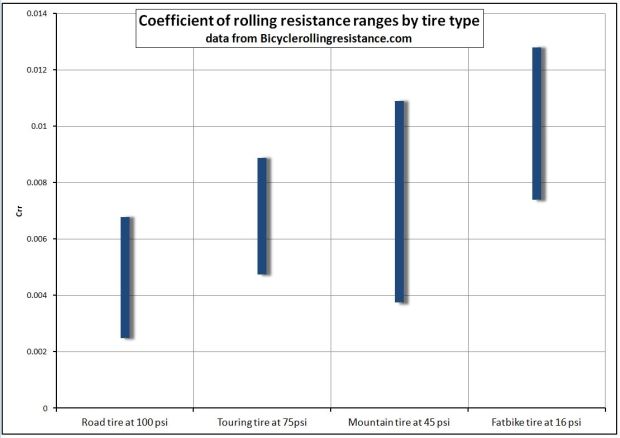Bicycle Rolling Resistance is a website run by Jarno Bierman in the Netherlands. Jarno* uses a roller to measure tire rolling resistance. The attraction of Jarnos’s work is that he uses a consistent method for a large number of different tires, and he uses a textured roller in an effort to account for energy loss from vibration as well as tire flex. The consistent test procedure gives me more confidence in his results than I have in roll-down test of just a few tire models, and the textured roller presumably approximates a real-world road surface better than a smooth roller.
However, he focuses on a narrow range of road tire sizes, staying close to 25 mm width. He treats stouter touring tires as a separate class, and he sticks to tires of around 37 mm for that group. Road and touring tires are all 700c. He has not yet directly explored the characteristics of wide light and supple tires.
He has, however, compared the rolling resistance of a particular model of high-performance road tires in different widths and concluded that the widest (28 mm) had the lowest rolling resistance (conti GP link ) . And he performed a similar test with a touring tire, showing that the 37 mm tire had lower rolling resistance than the 40 mm or 47 mm tire, while the 32 mm version had the highest rolling resistance for this tire model (Marathon link ).
However, the real outlier is in the mountain bike category. I am a little dubious of the usefulness of this test on knobby mountain bike and fat bike tires (since the knobs are larger than the roughness elements on the test roller — it seems to me that a more pertinent test would involve a rougher roller**), but the relatively smooth tires in this category should behave like road tires.
The best-performing tire in the mountain bike class has a rolling resistance that is competitive with the best 25 mm road tires, even with each class at inflation pressures appropriate to their widths. As one might expect, it has a very light tread and casing but measures 47 mm wide.
These results seem to show that wide/light/supple tires can be as fast as their proponents claim. Jarno has a long list of tires that he wants to test and not a lot of capacity to do the testing, but I would love to see him test some performance-oriented tires in the 38 mm range.

*I understand that you go straight to first names in the Netherlands rather than referring to someone with an honorific (e.g. Mijnheer Bierman) as you might in English. I prefer that informality, but I don’t want to sound disrespectful, and I apologize if I am incorrect.
**I think it might be useful to test tires on a series of rollers with different size roughness elements, comparable to Nikuradse’s experiments with pipes. This additional experimental data might provide some insight about optimum tires, width, and pressure for different surfaces.